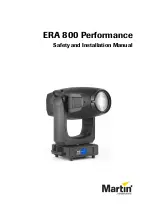
GLASS DRILL INSTRUCTION MANUAL
PRODUCT MANUAL
crlaurence.com
C.R. Laurence Co., Inc.
•
2503 E. Vernon Ave., Los Angeles, CA 90058
•
1.800.421.6144
•
crlaurence.com
NOVEMBER 2020
P. 23
8 REPAIR AND REPLACEMENT (CONT.)
8.6 Tank Heater Replacement
1. Before considering replacement, check heaters with amp probe (system power on) or ohmmeter (system power off,
wires disconnected). Determine resistance of each individual heater. Refer to electrical schematic.
2. Switch system power off and disconnect electrical power from external source.
3. Open control panel and remove tank access panel [1]. See illustration below.
4. Determine resistance of each individual heater [2].
5. Disconnect wires on defective heater.
6. Pull heater out of bore using pliers. If heater does not come out easily, drive out using a 6.35 mm (0.25 in.) diameter
rod inserted in knockout holes in back of tank base.
7. Apply a coating of heat release and transfer agent to new heater and slide it into tank heater bore from the front.
8. Route heater lead wires through electrical panel and reconnect heater wires in original locations. Refer to electrical
schematic included with melt unit.
9. Replace tank access panel [1].
10. Close and fasten control panel.
WARNING:
The over temperature thermostat is a necessary safety device for preventing runaway heating on all melt units.
Under no circumstances bypass this protection. Runaway heating of tank can cause hot melt materials to burst
into flames.
12
SS96 Hot Melt Unit 19600-135 Rev. B 10/26/00
DANGER:
To avoid personal injury, follow all
safety labels. Failure to properly operate and
maintain equipment can lead to serious injury.
•
Wear protective clothing, safety goggles and
safety gloves. Hot melt materials can cause
severe burns resulting in disfigurement or
blindness.
•
Use only manufacturer recommended materials
in this system. Fire, explosion, personal injury,
property and equipment damage can result if
improper or unsafe materials are used.
•
Disconnect electrical power from external
source to melt unit before undertaking
maintenance or troubleshooting. Failure to
disconnect power can result in fatal electrical
shock.
•
Depressurize system before performing any
maintenance to pump, pump filter, flow control
valve or hose. Turn pump switch off and
depress trigger on handgun until there is no
flow. Air trapped in the system or in a
component can form a pressure pocket.
Loosen fittings cautiously. Adhesive under
pressure can cause severe burns and
blindness.
•
Always read the manufacturer’s recommended
use of the material.
5.2 Startup Instructions
1.
Become familiar with Section 5.1, Controls and Indicators.
2.
Install melt unit as specified in Section 4, Installation.
3.
Fill tank with hot melt material.
4.
Turn melt unit on and allow sufficient warmup time for hot
melt material to thoroughly melt.
5.
Align motor on receipt of a new unit or after transportation.
a.
Loosen four screws holding motor pan to side of melt
unit.
b.
Heat melt unit and run motor. This centers the motor.
c.
With motor running, tighten four screws in a crisscross
pattern.
6.
Set hose and tank temperatures to desired settings. Lower
settings increase pot life of the material. Materials degrade
over time due to oxidation.
7.
To prevent motor stalling, adjust flow control valve to the
minimum flow requirement.
!
SS96 Hot Melt Unit 19600-135 Rev. B 10/26/00
25
WARNING:
The overtemperature thermostat is a
necessary safety device for preventing runaway
heating on all melt units. Under no circumstances
bypass this protection. Runaway heating of tank
can cause hot melt materials to burst into flames.
8.6 Tank Heater Replacement
1.
Before considering replacement, check heaters with amp
probe (system power on) or ohmmeter (system power off,
wires disconnected). Determine resistance of each individual
heater. Refer to electrical schematic.
2.
Switch system power off and disconnect electrical power from
external source.
3.
Open control panel and remove tank access panel [1]. See
illustration below.
4.
Determine resistance of each individual heater [2].
5.
Disconnect wires on defective heater.
6.
Pull heater out of bore using pliers. If heater does not come
out easily, drive out using a 6.35 mm (0.25 in.) diameter rod
inserted in knockout holes in back of tank base.
7.
Apply a coating of heat release and transfer agent to new
heater and slide it into tank heater bore from the front.
8.
Route heater lead wires through electrical panel and
reconnect heater wires in original locations. Refer to electrical
schematic included with melt unit.
9.
Replace tank access panel [1].
10. Close and fasten control panel.
!
1
2
2000351









































